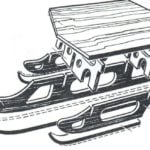A micromotorcycle is one of the simplest, most accessible and safest means of teaching teenagers how to ride in motoring towns. Purely externally, in terms of layout, it differs little from a “real” motorcycle. At the same time, it is lighter, more maneuverable, and its speed “ceiling” is relatively low.
In the design of micromotorcycles, common serial components and parts are widely used; only the frame and some load-bearing elements are manufactured independently. It is no coincidence that these small machines are so popular in technical circles.
However, external simplicity is deceptive. It takes a lot of work to get a good micro-motorcycle that meets modern requirements.
Here is one example of a largely successful, in our opinion, design solution found at the Vologda Regional Station for Young Technicians. The head of the automotive design laboratory, A. Krylov, talks about it.

1 — front fender, 2 — front fork, 3, 7 — fuel tank mounting brackets, 4 — frame, 5, 15 — engine mounting brackets, 6 — air filter, 8 — rear fender, 9 — reflector, 10 — rear shock absorber, 11 — spring, 12 — rear swing fork, 13 — brake lining, 14 — brake drive, 16 — ignition coil.
The guys joke that almost all the bicycle and motorcycle factories in the country worked on our micromotorcycle. Judge for yourself: the front fork and gas tank are from Riga, the headlight is from Vyatka, the rear shock absorber is from Voskhod, the wheels are from a go-kart, the Sh-57 engine with a muffler and air filter is from a moped. Not to mention the steering wheel, gas tap, chain, ignition coil, bearings…
Everything else is homemade. The frame is welded from inch and half-inch water pipes. In this case, templates and clamps were widely used to simplify the marking of parts and prevent deformation of the frame when cooling. One of the main conditions for the normal operation of a chain drive is strict parallelism of the shafts of the drive sprocket and the pendulum fork. That’s why we paid special attention to the installation of the engine mounting brackets and rear fork suspension tubes.
The seat tube was welded to the frame last. Before this, it was filled with sifted river sand, heated and bent.

1 — steering column, 2, 5 — fuel tank mounting brackets, 3 — supporting pipe, 4, 11 — engine mounting brackets, 6 — stiffener, 7 — seat tube, 8 — rear shock absorber mounting bracket, 9 — strut, 10 — strut, 12 — ignition coil mounting plate, 13 — air mount mounting lugs filter, 14 — seat supports, 15 — rear fender bracket, 16 — jumper, 17 — pad, 18 — rear fork axle bushing, 19 — footrest.
The telescopic front wheel fork with spring shock absorbers is from the Riga moped, shortened by 120 mm.
The rear suspension is spring-hydraulic. The upper shock absorber mounting bracket is located on the strut, the lower one is on the crossbar of the pendulum fork.
The front and rear fenders of the micromotorcycle are made of roofing iron.
The seat is made of foam rubber glued to a plywood base and covered with leatherette.
On the right footrest there is a brake pedal that acts only on the rear wheel. The friction type brake pad is made of sheet steel 2 mm thick in the form of a box, inside of which there is a rubber lining.
TECHNICAL CHARACTERISTICS OF THE MICROMOTORCYCLE
Weight, kg … 25
Engine displacement, cm3 … 49.8
Power, l. With. … 2.2
Maximum speed, km/h … 20
Main gear ratio… 2.6
A. KRYLOV



